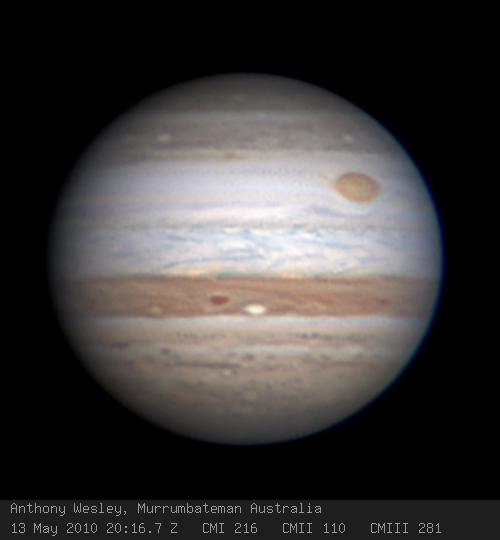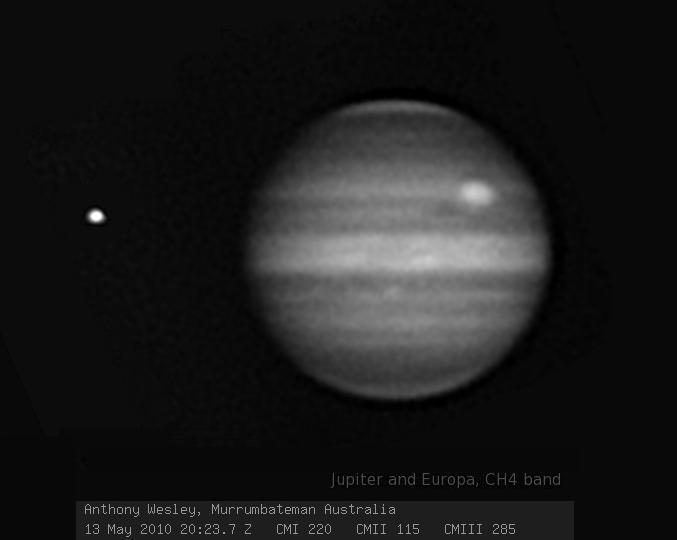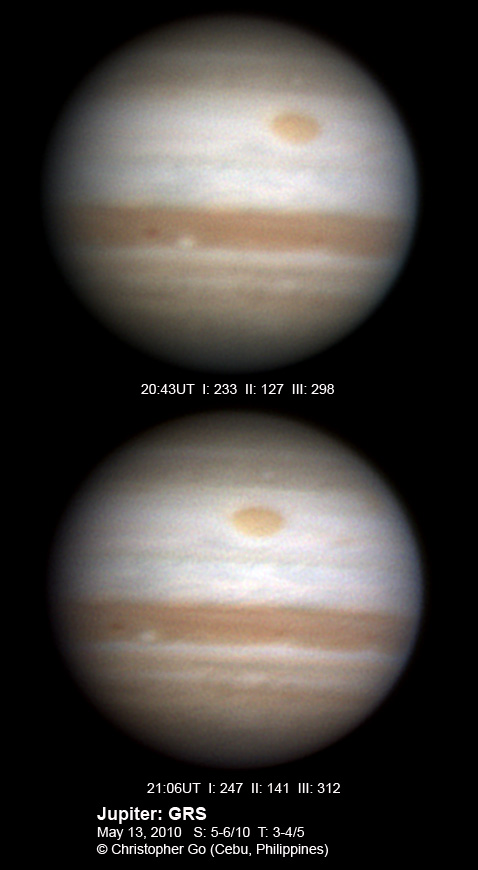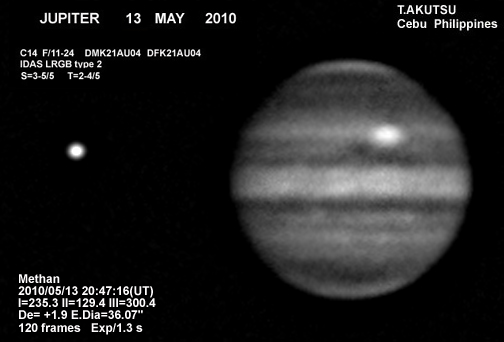木星 ALPO-Japan Latest

Jupiter Image 2010/05/13(UT)
阿久津富夫
Anthony Wesley,Christopher Go
Anthony,Christopher Go,T.Akutsu
|
Anthony Wesley (406mm Newton) |
seeing was ok but not great. The GRS is rising on the left. The N. half of the SEB appears pale pink (salmon?) with blue centre and the S. half is white. Prominent white and red spots on the NEB.
Comparing the methane image posted earlier,it's possible that the white spot is methane-bright and the red spot is methane-dark.

The seeing was quite reasonable for this image,115 frames @ 1s per frame. A couple of bright AWO's are visible at the bottom and hints of structure in the northern hemisphere. Europa is finishing transit and is very bright. The GRS has not yet risen,it's over the western limb by a few degrees.
The SEB is dark in this image,Jupiter looks almost normal

apologies in advance for the long-winded post,I'll be more concise in future
I received my Methane band filter yesterday (centered on 890nm ± 9nm) from Custom Scientific. I was very keep to try this out in conjunction with the new camera,the Flea3 should have some usable sensitivity still at this wavelength.
For those on this mailing list who are not familiar with methane-band imaging,it is used to show altitudes of clouds on Jupiter,brighter images indicate higher clouds where the light from the sun is more strongly reflected rather than being absorbed by the Jovian atmosphere.
Now,about sensitivity.. it's hard to give an exact answer because once again I was battling a thick fog this morning which would thin out and then come back with a vengeance,but I can say that when the transparency was good (not very often) I was able to use 0.66 second exposures at max gain,ie 1.5 frames per second,max gain on the camera.
I experimented with the slowest shutter available to me in my software,which is 1.05 seconds,and I was getting a very good histogram when shooting at my normal focal length of about 10m. You can see the actual size of Jupiter in the attached image,it has not been scaled up or down.
The biggest problem with a slow shutter is blurring due to poor seeing (had that as well) and movement of the target,so I was keen to find the "sweet spot",ie the fastest shutter that still gave me enough signal to stack. This morning that was 1.5fps,but I expect that the true max is around 2fps when Jupiter is higher and I'm not trying to image through fog...
In this image you can see Europa off to the side (very very bright),the GRS,also bright and a dark region preceding it. There is also a smaller bright spot in the NEB.
It's interesting to see that the SEB shows up in this image even though it's not really visible in normal light. There are also high clouds over the poles,as normally seen at thsi wavelength.
This image was made from stacking 90 raw frames,1 second exposure per frame during some stable seeing just before dawn.

[Anthony Wesley,Murrumbateman Australia]
≪アンソニ オーストラリア≫
|
Christopher Go (Celestron C11) |
Seeing was again poor this morning. Clouds were coming and going making imaging a bit frustrating.
The GRS can be seen in this image. It is very prominent! The NEB is still very broad and dark. The contrast between both hemispheres is obvious. The north is very red while the south is light!

[Christopher Go : Cebu Philippines]
|
Tomio Akutsu (355mmSC C14) |
GRSとBAが見えます、SEBの撹乱は、まだないようです。

 ≪Cebu PHILLIPINES 阿久津富夫≫
≪Cebu PHILLIPINES 阿久津富夫≫







≪Cebu PHILLIPINES 阿久津富夫≫
 ALPO-Japan Latest
ALPO-Japan Latest

 Jupiter Section
Jupiter Section